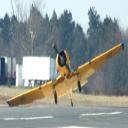Yahoo Answers is shutting down on May 4th, 2021 (Eastern Time) and beginning April 20th, 2021 (Eastern Time) the Yahoo Answers website will be in read-only mode. There will be no changes to other Yahoo properties or services, or your Yahoo account. You can find more information about the Yahoo Answers shutdown and how to download your data on this help page.
Trending News
Would deploying flaps increase the maximum altitude an aircraft could reach?
I'm thinking that stall due to lack of air density is a limiting factor, and flaps lower stall speed.
7 Answers
- 6 years agoFavorite Answer
No. The absolute ceiling of an aircraft is primarily a function of thrust vs drag. Deploying flaps increases drag, so even if lift were to increase with a small application of flaps, without additional thrust the gain would only be temporary and the absolute ceiling would actually be less.
- Vincent GLv 76 years ago
No, it will reduce it.,
Flaps increase lift but at the expense of an even larger increase in drag in proportion.
At take off and landing, the extra drag is less of an issue since you are operating at reduced velocities, but at altitude, a plane must fly as fast as possible to get the most lift. The ceiling is reached when the aircraft is getting the highest possible lift for a drag that is equal to the highest possible thrust at that highest possible speed.
Source(s): Aerospace engineer - Skipper 747Lv 76 years ago
Maximum altitude for extending flaps on a Boeing (any type) is 20,000 ft -
For the DC8 - flaps max speed (VFE) or Mach number is 230 KIAS or Mach.46 -
Would be impossible to extend flaps and be below 230/.46 at cruising altitude -
You would stall...
Your cruising altitude and speed margins are limited by the "Coffin Corner" -
And the weight at which you are cruising -
In other terms, remain between Vmo and Vs -
A heavy 747 can barely fly at 30,000 ft - yet if light, it could cruise at 45.000 ft -
Check that on Wikipedia -
What you are trying to say is to do like TWA 727 -
Extend trailing edge "flaps 2", and not extend leading edge flaps or slats -
See what happened to that airplane...!
http://en.wikipedia.org/wiki/TWA_Flight_841_(1979)
When I was F/O or F/E 727 in the 1970's, there were a few captains who did that -
We were lucky we never ended practicing snap rolls -
Source(s): Retired airline pilot - Anonymous6 years ago
No, the increased drag would counter any benefit of increased lift.
- How do you think about the answers? You can sign in to vote the answer.
- 0NE TRlCK P0NYLv 76 years ago
NO !!
That would slow the aircraft down and it would start to lose height.






